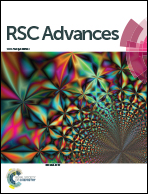Polysiloxanes-based stationary phases containing methoxy-substituted tetraphenyl–phenyl groups for gas chromotographic separations
Abstract
3,4-Di(4-methoxy phenyl)-2,5-diphenyl phenyl grafted polysiloxane (MTP) and 3,4-di(3,4,5-trimethoxy phenyl)-2,5-diphenyl phenyl grafted polysiloxane (TMP) were synthesized and statically coated on fused silica capillary columns. The MTP and TMP columns have efficiencies of almost 3400 (k = 3.74, 0.25 mm i.d.) and 3600 (k = 3.96, 0.25 mm i.d.) plates per m, respectively, which are determined by naphthalene at 120 °C. Both columns exhibited moderate polarity based on the McReynolds constants. The separation of the polyethylene pyrolysis products shows that the maximum operating temperature of the two columns can reach up to 360 °C and 370 °C, respectively. In addition, the solvation parameter indicated that the dipole–induced dipole, H-bond alkaline, and dispersive interactions were the main interactions between the solutes and the stationary phases. The separation performance of the new columns was evaluated by gas chromatography separation of the Grob test mixtures. Several mixtures with π-conjugated structure were also well separated on the new columns. This work demonstrated the promising future of the new type of stationary phases in GC analysis.



 Please wait while we load your content...
Please wait while we load your content...